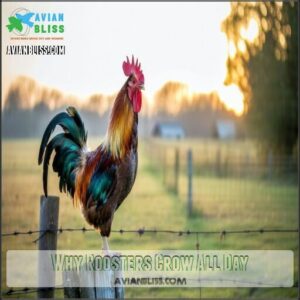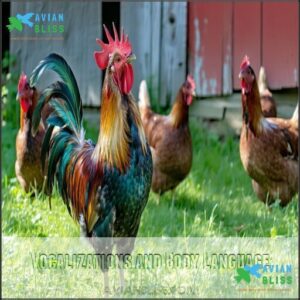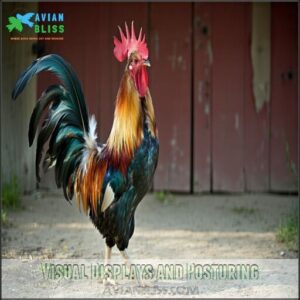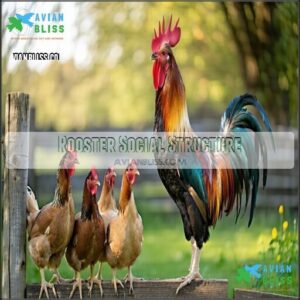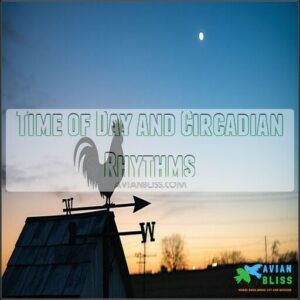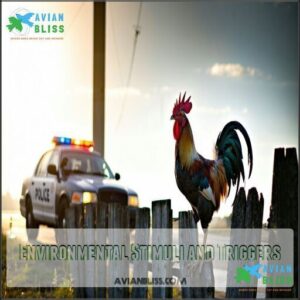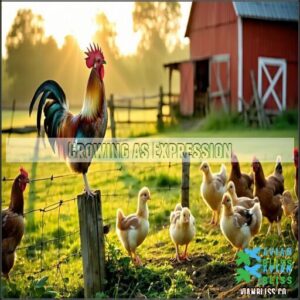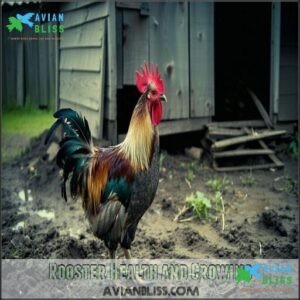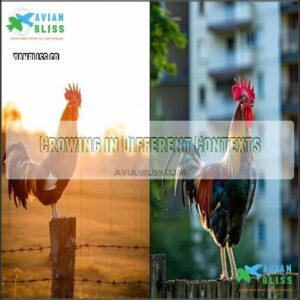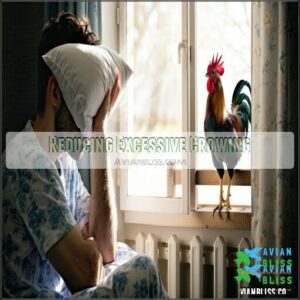This site is supported by our readers. We may earn a commission, at no cost to you, if you purchase through links.

Contrary to popular belief, roosters crow all day because they’re communicating constantly. They’re announcing territory boundaries, alerting their flock to potential dangers, responding to environmental changes, and maintaining their social status (think of it as their version of posting status updates).
Each crow serves a purpose in their chicken society, whether it’s saying "this space is mine" or "heads up, everyone—hawk overhead!"
Their internal biological clock certainly plays a role, but these feathered alarm clocks have much more to say than simply "good morning.
Table Of Contents
- Key Takeaways
- Rooster Crowing Behavior
- Why Roosters Crow All Day
- Rooster Communication Methods
- Rooster Social Structure
- Factors Influencing Crowing
- Crowing as Expression
- Managing Rooster Crowing
- Rooster Health and Crowing
- Crowing in Different Contexts
- Reducing Excessive Crowing
- Frequently Asked Questions (FAQs)
- Are roosters happy when they crow?
- Do roosters crow during the day?
- Why do roosters crow at night?
- Why does my rooster crow at 3 am?
- Why does a rooster crow at odd hours?
- Why does my rooster crow so much?
- What does it mean when a rooster crows?
- Why do top roosters crow a lot?
- Why is my rooster crowing all day?
- Why does my rooster crow constantly?
- Conclusion
Key Takeaways
- You’ll hear roosters crowing throughout the day because they’re constantly communicating—announcing territory, alerting their flock to dangers, and maintaining their social status in the chicken hierarchy.
- Your rooster’s internal biological clock, which runs on a 23.8-hour cycle, influences crowing patterns regardless of actual sunrise time, explaining why they might crow at odd hours like 3 AM.
- You can reduce excessive crowing by providing adequate space (at least 10 square feet per rooster), designing a secure coop that limits light infiltration, and offering enrichment activities to prevent boredom.
- When you notice changes in your rooster’s crowing patterns, it could signal health issues—proper nutrition, regular exercise, and veterinary care directly impact their vocal strength and frequency.
Rooster Crowing Behavior
You’ve probably noticed that roosters seem to crow at all hours, but it’s not just random noise—they’re communicating important messages.
From claiming their turf to warning the flock of danger, every crow has a purpose, even if it feels like they’re auditioning for a 24/7 alarm clock role.
Signaling The Start of a New Day
Roosters crow at dawn to signal the start of a new day, guided by their internal clock and light sensitivity, rather than the sun itself.
It’s not about sunrise; it’s a daily rhythm that stays intact, even in bad weather.
- Driven by a 23.8-hour biological cycle.
- Crowing begins hours before daylight peaks.
- Light changes trigger crowing reactions.
- Historical dawn association debunked, showing that crowing is linked to an internal biological cycle.
Establishing Their Territory
You might think it’s just noise, but crowing is how roosters stake their claim.
It’s all about territoriality—defending boundaries, controlling resources, and keeping competitors out.
These dominance displays send a clear message: "This space is mine!"
If another rooster challenges, expect a boundary dispute with more crowing.
It’s nature’s version of a “No Trespassing” sign, rooster-style!
Roosters use this to secure access to vital resources.
Establishing Flock Hierarchy
In the context of flock dynamics, rooster dominance is no joke.
Crowing helps establish the pecking order, keeping everyone in line.
You’ll notice:
- Dominance Displays: Loud crowing asserts authority over hens and rival roosters.
- Territorial Disputes: Crow-offs settle who rules the roost.
- Stress Factors: Close quarters amplify rooster territoriality, fueling constant reminders of who’s boss.
It’s their version of office politics!
Warning The Flock of Danger
Just as roosters establish hierarchy, they’re also the flock’s security system.
When a predator lurks, their sharp alarm calls warn everyone to stay alert.
This instinctive threat response keeps the flock safe, whether it’s a sneaky fox or a harmless shadow.
Rooster crowing reasons often boil down to flock safety, proving these feathered sentinels take coop security seriously—even against butterflies!
Why Roosters Crow All Day
It’s not just mornings when you hear that iconic “cock-a-doodle-doo.” Rooster crowing all day happens for a bunch of reasons, and trust me, they’ve got their motives.
Their internal clock, running on a 23.8-hour cycle, keeps them crowing at odd times, even before sunrise. Environmental triggers like barking dogs, passing cars, or even your doorbell can set them off. And don’t forget the social drama—roosters love to show off or challenge rivals.
Here’s why they keep at it:
- Communication: Crowing warns the flock of danger or signals food discoveries.
- Territorial Claims: It’s their way of saying, “This is my turf—back off!”
- Dominance Battles: Multiple roosters nearby? Expect crowing contests to prove who’s boss.
If it feels constant, addressing stress, space, or boredom might help tame the noise; you can also try providing mental stimulation and toys.
Rooster Communication Methods
Roosters don’t just crow to make noise—they’re actually chatting with their flock, sending out warnings, or showing off their confidence.
From vocal calls to dramatic struts, their communication methods are like a feathery version of texting and body language combined!
Vocalizations and Body Language
Rooster crowing isn’t just noise; it’s their way of chatting! From alarm calls to soft clucks, vocalizations reveal everything from danger to dinner invites.
Pair that with body postures like puffed chests or flared feathers, and you’ve got a full communication toolkit. Birds also use visual displays to communicate intentions.
| Vocalization Type | Meaning | Example Behavior |
|---|---|---|
| Alarm calls | Warns of danger | Loud, high-pitched crowing |
| Soft clucking | Attracts hens to food | Gentle “perp-perp” sounds |
| Fighting sounds | Signals aggression | Hackle feathers flared |
Visual Displays and Posturing
When it’s not about rooster crowing, it’s about their visual drama.
Dominance displays like puffed chests and flared hackle feathers scream, “I’m the boss!”
Mating rituals feature the sideways dance, a mix of charm and swagger.
Threat postures—circling, intense eye contact, and lowered wings—warn rivals to back off.
Even their comb appearance can signal health and authority in rooster communication.
Auditory Signals and Alarm Calls
While puffed chests and feather fluffs grab attention, rooster sounds like predator warnings and distress vocalizations are the flock’s alarm system.
A loud crow can signal danger—a hawk, a sneaky raccoon, or even your cat wandering too close.
These animal alerts aren’t just noise pollution; they’re essential for coop security and flock communication, keeping everyone safe from predators lurking nearby.
Rooster Social Structure
Roosters don’t just crow for fun—they’re managing a complex social system where dominance is everything.
From bossy struts to loud crows, they’re like feathered CEOs keeping their flock in line and rivals at bay.
Dominance and Submission
Sometimes, it’s like a soap opera in the coop! The Alpha Rooster rules the roost, using rooster crowing to assert dominance and keep rivals in check.
Challenging dominance? That’s risky—losers drop in the Pecking Order. Submission signals, like lowered heads, restore Flock Harmony.
This animal dominance dance guarantees everyone knows their place, keeping territorial behavior from spiraling into chaos. Dominant birds often gain priority access to resources like food.
Pecking Order and Hierarchy
In the realm of rooster behavior, the pecking order isn’t just a phrase—it’s their way of life.
Social ranking keeps the flock running smoothly, with dominance displays like rooster crowing and chest-puffing settling disputes.
Challenges can shake up hierarchy stability, but it’s all about maintaining order.
Think of it as their version of office politics, minus the coffee breaks!
Rooster Roles and Responsibilities
A rooster’s job isn’t just about rooster crowing; they’re the flock’s superhero! They keep everyone safe, guide chicks like feathery tour guides, and pass on strong genetics. Plus, they’re natural pest controllers.
- Flock Protection: They sound rooster alerts to warn of predators.
- Chick Guidance: Teaching young ones survival skills.
- Breed Qualities: Ensuring healthy, strong offspring.
Factors Influencing Crowing
If you’ve ever wondered why roosters seem to crow non-stop, it’s not just random noise—they’ve got their reasons.
From their internal clocks to reacting to the world around them, these feathered alarm clocks are far more complex than they let on.
Time of Day and Circadian Rhythms
Just like your alarm clock, a rooster’s internal clock keeps them on a daily schedule.
Their circadian rhythm, tuned to light sensitivity, kicks off rooster crowing long before dawn.
It’s not about the sunrise—it’s their biological sleep patterns at work.
Nocturnal crowing? Blame their overachieving clocks, always ready to announce the day, even in pitch darkness!
Environmental Stimuli and Triggers
Rooster crowing triggers often stem from external stimuli like light exposure, noise pollution, or predator presence.
A sudden car honk, a dog barking, or even a flickering streetlight can set them off.
Human interaction, like entering the coop, adds to the chaos, and their coop environment plays a role too—small changes spark behavioral triggers, keeping them vocal all day, due to external stimuli.
Social Interactions and Flock Dynamics
While environmental noises spark rooster crowing, chicken flock dynamics play a big role too.
Roosters use crowing to assert dominance, maintain the pecking order, and reinforce their roles.
It’s like a daily meeting—full of dominance displays and social bonding.
Flock communication through rooster crowing keeps everyone in line, ensuring territory boundaries are clear and rivalries don’t spiral into chaos.
Crowing as Expression
Roosters don’t just crow to be noisy—they’re actually sharing their feelings, staking their claim, or bonding with their flock.
Think of it as their way of saying, “This is my turf, and I’m proud of it!”
Emotional and Psychological Aspects
Sometimes, rooster crowing isn’t just noisy—it’s emotional!
Crowing frustration often stems from rooster anxiety or boredom triggers, like limited space or toys.
Happy roosters, feeling flock contentment, crow less.
But add territorial stress or boredom, and they chatter all day, releasing pent-up energy.
It’s animal behavior 101—rooster behavior mirrors emotional ups and downs, proving they’re small chicken drama kings!
Social Bonding and Affiliation
When roosters crow, they’re not just making noise—they’re fostering relationships.
Crowing strengthens flock integration and acts as a greeting for absent members.
It’s like a rooster’s way of saying, “Hey, I’m here; all’s good!”
This behavior boosts rooster relationships and social learning within the group.
Their crowing isn’t random; it’s chicken behavior rooted in powerful animal communication, which helps in fostering relationships.
Territorial Marking and Defense
Ever notice a rooster crowing like he’s auditioning for “The Loudest Bird” award?
Roosters use crowing contests and dominance displays to mark territory, warning rivals to back off.
If another rooster dares, expect fence leaping and a showdown—classic animal territoriality at play.
They’ve mastered threat perception, using their voices as alarms and their coop as their kingdom.
Managing Rooster Crowing
If your rooster’s nonstop crowing has you ready to trade him for a quieter alarm clock, don’t worry—there are ways to manage it.
By tweaking their environment and using clever tools like no-crow collars, you can turn down the volume without ruffling too many feathers!
Environmental Enrichment and Stimulation
Feeling like your roosters are throwing a non-stop crowing party?
Keep them busy! Environmental enrichment works wonders—try puzzle feeders to challenge their brains, or fun chicken toys to curb boredom.
A well-planned coop design meets your flock’s space needs, satisfying natural chicken behavior.
Happy chickens are quieter chickens, proving even rowdy roosters can chill with the right activities and enrichment.
Behavioral Modification and Training
Building on enrichment techniques, behavioral modification and training can curb crowing.
Use positive reinforcement, like treats, to reward silence. Early socialization fosters calmer roosters, while coop training reduces stress.
Crowd desensitization helps with external triggers, and redirecting behavior—such as distracting with feeding techniques—works wonders.
Identifying behavioral triggers makes rooster behavior modification smoother, keeping your flock harmonious and your mornings less noisy, with the use of positive reinforcement.
Rooster Collars and Noise Reduction
If you’re searching for humane rooster crowing solutions, nocrow collars are a clever option.
These devices reduce noise by slightly restricting airflow while keeping your bird safe.
Here’s what to know:
- Collar Effectiveness: Results vary by rooster.
- Collar Safety: Proper fit prevents harm.
- DIY Collars: Affordable, but tricky.
- Ethical Concerns: Always prioritize comfort!
To purchase these, consider a rooster nocrow collar.
Noise control never looked so thoughtful!
Rooster Health and Crowing
If your rooster won’t stop crowing, it might be his way of saying he’s not feeling his best.
Poor nutrition, lack of exercise, or even undiagnosed health issues could be behind all that nonstop noise.
Nutrition and Diet
Your rooster’s crowing is directly linked to what’s on his menu, with a balanced diet supporting the energy levels needed for that iconic "cock-a-doodle-doo."
Nutritional deficiencies can silence even the most vocal birds, while high-quality chicken feed maintains crowing frequency, and feed timing matters too—hungry roosters crow more.
Consider calcium intake, as it affects overall health and vocal strength, and toss in occasional chicken treats, which will show how dietary impact translates to happier, more musical birds.
This behavior is largely due to their internal circadian clock, highlighting the importance of a well-managed dietary routine.
Exercise and Physical Activity
A rooster with plenty of room to stretch his wings is a happier, healthier bird with more normal crowing patterns.
Regular exercise supports your rooster’s respiratory health, directly affecting his robust morning announcements.
Here’s how physical activity impacts crowing:
- Daily foraging behavior reduces stress-related excessive crowing
- Dust bathing opportunities improve feather condition and overall well-being
- Practicing predator evasion through exercise keeps roosters alert without triggering panic crowing
This reorganization highlights the importance of exercise for a rooster’s health and crowing patterns, making it easier to understand the relationship between physical activity and a rooster’s behavior.
Health Issues and Veterinary Care
While roosters typically crow with gusto, changes in their vocal patterns can signal trouble brewing.
If you notice your rooster’s crow becoming raspy or if he stops crowing altogether, it might indicate illness indicators like Chronic Respiratory Disorder or injury impact.
Stress effects from bullying or hierarchy disputes can also silence subordinate birds.
Regular veterinary options and check-ups are essential for maintaining rooster health and addressing issues before they impact your flock’s welfare.
Crowing in Different Contexts
You’ll notice your rooster’s crowing habits change dramatically based on where you keep him, with city birds often crowing more cautiously while farm roosters belt out confident calls across open fields.
Whether you’re raising chickens in your suburban backyard or on a sprawling homestead, understanding these context-specific behaviors will help you manage your feathered alarm clock more effectively.
Urban and Rural Environments
The contrast between urban and rural environments dramatically affects how roosters and their crowing are perceived.
In urban neighborhoods, you’ll face strict noise regulations and coop size limits that can make keeping roosters challenging.
Meanwhile, rural life offers freedom for natural rooster behaviors without community impact concerns.
You’ll notice roosters adapt differently too—farm birds often crow more confidently than their city counterparts who’ve learned to moderate their announcements.
Farming and Agricultural Settings
Within traditional farms, roosters serve purposes beyond their morning alarm duties. Their persistent crowing creates a rhythm that defines agricultural life.
Your farm roosters contribute to the agricultural setting in several ways:
- Acting as livestock guardian roles by alerting to predators
- Maintaining the farm ecosystem impact through flock management
- Helping establish community relations as iconic farm animals
Despite concerns about rural noise pollution, many agricultural zoning laws specifically protect a rooster’s right to crow.
Cultural and Symbolic Significance
From fields to cultural landscapes, the rooster’s crow carries deep meaning across civilizations.
You’ve probably seen weathercocks atop churches or heard the expression "until the cock crows."
These aren’t random choices!
Throughout history, rooster crowing has symbolized vigilance, resurrection, and dawn’s arrival.
In folklore associations, cockcrows ward off evil spirits, while religious significance ties them to watchfulness.
Artistic depictions and rooster mythology showcase their status as solar symbols in nearly every culture.
Reducing Excessive Crowing
You’ll be amazed at how simple adjustments to your coop design and daily chicken routine can transform your noisy rooster into a more considerate neighbor.
With strategic space management, proper light control, and enrichment activities that keep your feathered alarm clock entertained, you’ll finally be able to enjoy your morning coffee without the constant soundtrack of cock-a-doodle-doos.
Providing Adequate Space
Spaces that are too tight make roosters feel like they’re living in a pressure cooker! Your chicken coop size directly impacts crowing frequency.
When roosters don’t have enough territory size to call their own, territorial marking behaviors skyrocket. Each rooster needs at least 10 square feet of personal space to reduce stress-related crowing.
Overcrowding effects include increased aggression and constant noise as they compete for dominance.
Free-range benefits include natural roosting space where roosters can spread out, dramatically reducing their need to vocally defend every inch, which helps reduce stress-related crowing and promotes a more peaceful environment with less aggression.
Ensuring Proper Coop Design
Smart chicken coop design substantially reduces excessive crowing.
You’ll want to focus on predator protection with secure fencing and locks that make your rooster feel safe enough to stay quiet.
Proper ventilation needs balance with darkness—block light that might trigger pre-dawn crowing.
Consider roosting height (they prefer elevated spots) and nesting comfort in your chicken coop size planning.
A well-designed chicken run gives them space to patrol without feeling threatened.
Consider optimal coop layouts for minimizing stress and creating a comfortable environment with secure fencing.
Minimizing Stress and Boredom
Bored roosters crow up into the late hours just like restless teenagers make noise when they’re unstimulated.
To minimize stress and prevent excessive crowing, try these proven enrichment activities:
- Hang cabbage heads for pecking entertainment
- Scatter treats under straw for natural foraging
- Introduce puzzle feeders that dispense food gradually
- Provide chicken toys like mirrors or hanging CDs
- Create dust bathing areas with fine sand or dirt
Consider purchasing rooster enrichment toys for added stimulation to keep your roosters engaged and happy with enrichment activities.
Frequently Asked Questions (FAQs)
Are roosters happy when they crow?
Cheerful chicks crow to communicate!
Your rooster’s not just happy—he’s expressing dominance, marking territory, or warning of danger.
It’s his natural way of talking, like you’d shout when you’re excited or concerned.
Do roosters crow during the day?
Yes, roosters absolutely crow during the day!
You’ll hear them sounding off throughout daylight hours to establish territory, show dominance, alert their flock to potential threats, or simply announce their presence proudly.
Why do roosters crow at night?
Midnight melodies mystify many.
Your rooster’s nighttime crowing happens due to his internal clock, reactions to disturbances, territorial instincts, or simply responding to other roosters.
It’s part of their biological programming, not just a morning thing, and is influenced by their internal clock.
Why does my rooster crow at 3 am?
Your rooster’s 3 AM wake-up call happens because his internal biological clock runs on a 8-hour cycle.
He’s not trying to annoy you—he’s just following his natural rhythm, regardless of actual sunrise time!
Why does a rooster crow at odd hours?
Your feathered alarm clock isn’t just programmed for sunrise.
Roosters crow at odd hours due to their internal biological clock, reactions to environmental triggers, territorial instincts, and responses to perceived threats around your coop.
Why does my rooster crow so much?
Your rooster’s constant crowing is his way of asserting dominance, marking territory, and communicating with his flock.
He’s basically showing off, responding to perceived threats, or simply following his internal biological clock.
What does it mean when a rooster crows?
When your rooster belts out his signature call, he’s basically shouting "this is MY territory!"
He’s also communicating with his flock, warning of dangers, or simply showing off his dominance to other roosters.
Why do top roosters crow a lot?
King of the hill, your top rooster’s constant crowing is all about showing who’s boss.
He’s asserting dominance, marking territory, and letting other roosters know they’d better not mess with his ladies.
Why is my rooster crowing all day?
Your rooster’s all-day concert isn’t just to annoy you!
He’s asserting dominance, marking territory, responding to threats, or showing off to his hens.
It’s his way of saying "I’m the boss around here!
Why does my rooster crow constantly?
Your feathered alarm clock is crowing constantly to assert dominance, define territory, respond to threats, communicate with hens, and follow his biological clock.
It’s his way of saying "I’m in charge here!
Conclusion
Like a feathered symphony conductor, your rooster isn’t just making noise—he’s orchestrating complex social communications throughout the day.
Now that you understand why roosters crow all day, you’ll appreciate their vocalizations as meaningful signals rather than random noise.
Whether they’re establishing territory, warning of danger, or maintaining social hierarchy, these dynamic birds have plenty to say.
With proper management techniques, you can enjoy your rooster’s personality while keeping the peace with your neighbors.
- https://www.grit.com/animals/poultry/chickens/why-do-roosters-crow-all-day-zm0z24jazols/
- https://www.thechickentractor.com.au/why-do-roosters-crow/?srsltid=AfmBOooIEFjinGnyCUkHf5vK0vOY4L_za4kQieAkRSjdvZ6JrCWna8q3
- https://www.hobbyfarms.com/boy-talk-common-reasons-a-rooster-will-crow/
- https://www.almanac.com/why-do-roosters-crow-10-riveting-facts-about-roosters
- https://pets.stackexchange.com/questions/31712/what-can-be-done-to-stop-roosters-from-crowing-all-day-and-night


